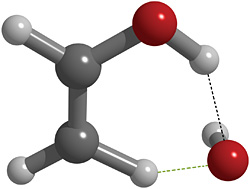

Main navigation | Main content
08/19/2010
Recent research from the research group of Professor Donald Truhlar.
A computational study of the reaction between a hydroxyl radical and a vinyl alcohol molecule shows that the reaction likely proceeds by one pathway at low temperature and a quite different pathway at high temperature, report Oksana Tishchenko, Sonia Ilieva, and Donald G. Truhlar of the University of Minnesota, Minneapolis (J. Chem. Phys. 2010, 133, 021102). Understanding hydrocarbon oxidation mechanisms is important for modeling atmospheric chemistry and combustion processes, both of which involve enol intermediates. Mechanisms involving compounds with double bonds such as vinyl alcohols can be particularly hard to model, Truhlar says, because the often small energy difference between the highest occupied and lowest unoccupied molecular orbitals necessitates consideration of multiple orbital occupancies in the starting wave function. Truhlar’s group investigated hydroxyl radical addition across the carbon-carbon double bond of vinyl alcohol and hydrogen abstraction from the carbons and oxygen. They found that the addition reaction is more likely to occur at atmospheric temperatures, but hydrogen abstraction is more likely at the high temperatures of combustion. Abstraction from the β carbon is particularly favored, the researchers note, because a hydrogen bond between the hydroxyl oxygen and alcoholic hydrogen stabilizes the transition state.

Hydrogen abstraction from the β carbon of vinyl alcohol by a hydroxyl radical (represented by green dotted line) is promoted by a hydrogen-bonding interaction between the hydroxyl oxygen and the alcohol’s hydrogen; C is gray, O is red, and H is white.